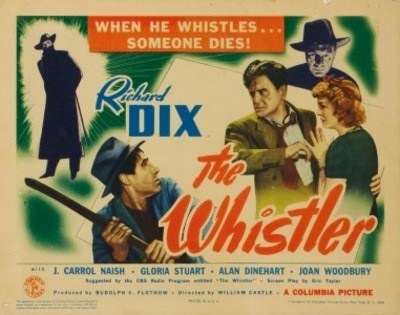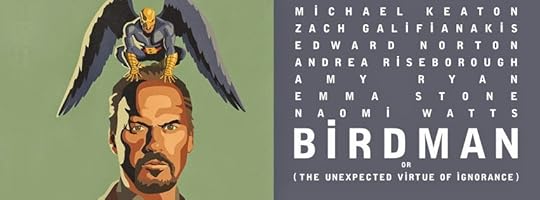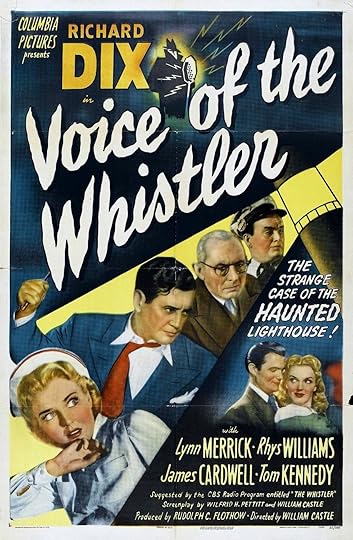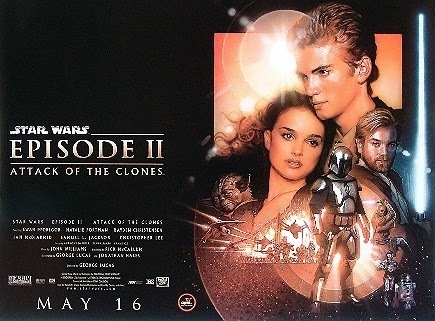Movies I Watched In November, Part 3
December is just about over, so I'd better finish up this recap of movies I saw in November...

I'm a big fan of the "Whistler" movies, a series of B pictures released in the mid to late 1940s. Based on a radio show and introduced by "The Whistler," a never-seen narrator, they featured different characters in sort of proto-noir storylines, and most of the films starred actor Richard Dix in the lead role. In this movie, released in 1945 and directed by the legendary William Castle, the plot focuses on a wealthy industrialist who discovers he's dying and decides to leave the rat race, marries a nurse for companionship and live peacefully in a lighthouse. Things go wrong, of course, mostly because the nurse turns out to be money hungry, the industrialist discovers he's not dying and, to top things off, the nurse's old fiance shows up at the lighthouse. It's all a little crazy and nonsensical, but the low budget adds some interesting atmosphere (especially at the free clinic where the doctor and nurse work), and Dix, as always, brings an interesting sense of desperation to the role. Plus, it's only about an hour long, meaning it moves quickly and won't take up much of your time. They run frequently on TCM, so check one out the next time you get a chance -- it beats watching another hour of some goddamn reality show.

I wrote more than once about how much I was anticipating this movie, and I definitely was not disappointed. I also wasn't expecting the movie I got, which, more than anything, is a backstage drama. Michael Keaton plays the has-been actor (and former super-hero star) trying to jump-start his career with an ultra-serious Broadway play based on the works of Raymond Carver. That synopsis only begins to scratch the surface of "Birdman," though. For one thing, there's the usual backstage intrigue, with a possibly pregnant lover/co-star (Andrea Riseborough), an arrogant co-star (Edward Norton, great), a nervous co-star making her Broadway debut (Naomi Watts) and a troubled daughter (Emma Stone). Plus, the Birdman character becomes an actual presence in the film, giving Keaton powers (maybe) and appearing in the flesh toward the end (again, maybe). But despite all that -- and it's a lot, I'll admit -- what's the most memorable about "Birdman" is the way director Alejandro Gonzalez Inarritu and cinematographer Emmanuel Lubezki make the theater itself a character in the movie (arguably the man character) by constantly swooping and gliding the camera through the hallways, staircases, dressing rooms and backstage areas. (The entire movie is designed to look like a single take, even though the story takes place over about a week's time.) It's an amazing, visually stunning experience, and one best seen on the big screen.

Here's the first in the "Whistler" series, which I wrote about back in October 2012. The plot this time around involves a man (Richard Dix again) who hires a hitman to murder him, then changes his mind but can't contact the hitman to call off the job. Lots of fun, like the others in the series, with an interesting performance by J. Carroll Naish as an unusually introspective (bordering on existential) killer. Again, I highly recommend checking it out the next time it (inevitably) airs on TCM.

All three prequels are bad, but this one is the worst. The terrible dialogue. The asinine plot. The boring political intrigue. The gasp-inducing romance. The scene where Threepio's head gets stuck on another robot's body. The scene set in a 1950s diner. The confusing battles. Yoda embarrassing himself with a lightsaber. The unconvincing digital everything. It's all so, so bad. But my daughter enjoys it, so I watch it -- and keep my comments to a minimum. But she doesn't read this blog, so...

I'm a big fan of the "Whistler" movies, a series of B pictures released in the mid to late 1940s. Based on a radio show and introduced by "The Whistler," a never-seen narrator, they featured different characters in sort of proto-noir storylines, and most of the films starred actor Richard Dix in the lead role. In this movie, released in 1945 and directed by the legendary William Castle, the plot focuses on a wealthy industrialist who discovers he's dying and decides to leave the rat race, marries a nurse for companionship and live peacefully in a lighthouse. Things go wrong, of course, mostly because the nurse turns out to be money hungry, the industrialist discovers he's not dying and, to top things off, the nurse's old fiance shows up at the lighthouse. It's all a little crazy and nonsensical, but the low budget adds some interesting atmosphere (especially at the free clinic where the doctor and nurse work), and Dix, as always, brings an interesting sense of desperation to the role. Plus, it's only about an hour long, meaning it moves quickly and won't take up much of your time. They run frequently on TCM, so check one out the next time you get a chance -- it beats watching another hour of some goddamn reality show.

I wrote more than once about how much I was anticipating this movie, and I definitely was not disappointed. I also wasn't expecting the movie I got, which, more than anything, is a backstage drama. Michael Keaton plays the has-been actor (and former super-hero star) trying to jump-start his career with an ultra-serious Broadway play based on the works of Raymond Carver. That synopsis only begins to scratch the surface of "Birdman," though. For one thing, there's the usual backstage intrigue, with a possibly pregnant lover/co-star (Andrea Riseborough), an arrogant co-star (Edward Norton, great), a nervous co-star making her Broadway debut (Naomi Watts) and a troubled daughter (Emma Stone). Plus, the Birdman character becomes an actual presence in the film, giving Keaton powers (maybe) and appearing in the flesh toward the end (again, maybe). But despite all that -- and it's a lot, I'll admit -- what's the most memorable about "Birdman" is the way director Alejandro Gonzalez Inarritu and cinematographer Emmanuel Lubezki make the theater itself a character in the movie (arguably the man character) by constantly swooping and gliding the camera through the hallways, staircases, dressing rooms and backstage areas. (The entire movie is designed to look like a single take, even though the story takes place over about a week's time.) It's an amazing, visually stunning experience, and one best seen on the big screen.

Here's the first in the "Whistler" series, which I wrote about back in October 2012. The plot this time around involves a man (Richard Dix again) who hires a hitman to murder him, then changes his mind but can't contact the hitman to call off the job. Lots of fun, like the others in the series, with an interesting performance by J. Carroll Naish as an unusually introspective (bordering on existential) killer. Again, I highly recommend checking it out the next time it (inevitably) airs on TCM.

All three prequels are bad, but this one is the worst. The terrible dialogue. The asinine plot. The boring political intrigue. The gasp-inducing romance. The scene where Threepio's head gets stuck on another robot's body. The scene set in a 1950s diner. The confusing battles. Yoda embarrassing himself with a lightsaber. The unconvincing digital everything. It's all so, so bad. But my daughter enjoys it, so I watch it -- and keep my comments to a minimum. But she doesn't read this blog, so...
Published on December 21, 2014 18:46
No comments have been added yet.
Will Pfeifer's Blog
- Will Pfeifer's profile
- 23 followers
Will Pfeifer isn't a Goodreads Author
(yet),
but they
do have a blog,
so here are some recent posts imported from
their feed.



